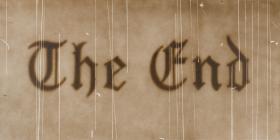1. Show students Ed Ruscha’s painting, Scratches on the Film [additional background info below]. Ask students:
What does this painting remind you of?
What do you think inspired the artist?
How do words, color, and font all communicate a meaning in this work of art? For example: Where do you usually see the words “The End”? How would you describe the visual appearance of the words? What font, or style of writing, has the artist used?
How does the style of writing influence how you interpret the words?
What colors does the artist use in the painting? How do these colors contribute to the subject and mood of the painting?
2. Discuss the role of reflection and personal expression in writing and art. Tell students that this painting is one of a series inspired by the artist’s memories of watching movies as a child. Have students write a reflective essay about their own memories and feelings about writing, rather than the movies. Ask them to consider:
What do you remember about learning how to write? What assignments or exercises did you do to practice writing? When and how did you learn to write cursive? How did you feel about writing? When would you write—just for school or for yourself, too? How do you feel now when you get a writing assignment? What makes writing easy or hard for you? What are the different ways you use writing?
3. After students write their reflective essay, ask them to select one word or phrase that best describes their feelings and attitudes about writing. Have students write a brief explanation about their selection in their writing journals.
4. Ask students to create a work of art inspired by Ruscha’s Scratches on the Film. Tell them to use their selected word or phrase, select a style of writing (or font if using a computer program), and choose a color that corresponds to their word or phrase. Remind students to consider the discussion about Ruscha’s painting from the beginning of the lesson when planning the design of their art. Students may use their writing journals to plan their design.
5. Show students the wall label for Ruscha’s painting (below). Explain that a label usually provides some insight into a work of art. Ask them to write a brief paragraph for their own work using their writing journals as a reference. Display the student art and label in the classroom or an exhibition space within the school.
Wall label for Ruscha painting:In Scratches on the Film, Ruscha exploits the canvas nap to convincingly create the surface texture of an old piece of film, scratched and faded to a sepia color. Floating on the simulated celluloid are the final words of a vintage movie, "The End," spelled out in gothic lettering. The oversized, old-fashioned typeface immerses viewers in the nostalgic romanticism of old movies, a mood done in by the apocalyptic implications of the inscribed message and the creeping realization that the artist's tone might well be mock-serious. By giving everyday phrases glorified treatment, Ruscha encourages a reconsideration of the complex relation between word and image, as well as between word and speaker.
The reflective writing essay will demonstrate students’ ability to respond to personal experience.
The work of art and label text will demonstrate students’ ability to communicate intended meaning visually and verbally.
The writing journal will show students’ reflection over the course of the project and ability to monitor individual comprehension.
label
paper, paints, colored pencils, markers, pencils, or art materials of choice
In Scratches on the Film, Ruscha exploits the canvas nap to convincingly create the surface texture of an old piece of film, scratched and faded to a sepia color. Floating on the simulated celluloid are the final words of a vintage movie, "The End," spelled out in Gothic lettering. The oversized, old-fashioned typeface immerses viewers in the nostalgic romanticism of old movies, a mood done in by the apocalyptic implications of the inscribed message and the creeping realization that the artist's tone might well be mock-serious. By giving everyday phrases glorified treatment, Ruscha encourages a reconsideration of the complex relation between word and image, as well as between word and speaker.


